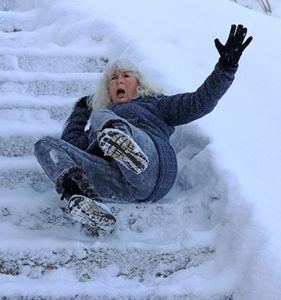The Hidden Dangers of Slipping on Ice: How a Simple Fall Can Lead to Long-Term Damage
In the Midwest, winter brings snow, ice, and the dreaded risk of slipping. While an icy tumble might seem a temporary inconvenience, falls on ice can cause more damage than you think. Whether it’s a broken bone, a painful sprain, or hidden joint damage, the impact of an icy spill can last well beyond winter.
Why Do We Fall on Ice?
Ice creates an unstable surface that reduces friction, making it easy for feet to slide unexpectedly. When a foot slips forward, the body falls backward, often resulting in head injuries, wrist fractures, or tailbone damage. If a foot slides backward, the body lunges forward, increasing the risk of hand, elbow, or facial injuries. Sideways falls can twist the knee or ankle, leading to ligament tears or fractures in the wrist, hip, or shoulder. The body’s instinctive reaction to regain balance—tightening muscles—can further increase the risk of strains and soft tissue injuries.
Common Injuries from Slippery Falls
Slipping on ice can cause anything from minor bruises to severe fractures. The most common injuries include:
- Fractures: Wrists, hands, hips, and ankles are especially vulnerable, as people instinctively try to catch themselves or absorb impact. Hip fractures are particularly concerning for older adults, often requiring surgery and long recovery times.
- Sprains and Strains: Twisting motions during a fall can stretch or tear ligaments, leading to painful sprains in the ankle, knee, or wrist.
- Tailbone and Spine Injuries: Landing directly on the tailbone can cause lingering pain, while more serious falls may lead to spinal injuries or nerve damage.
- Joint Damage and Long-Term Effects: Even seemingly minor falls can wear down cartilage, trigger bursitis, or cause chronic pain and stiffness, increasing the risk of arthritis over time.
How to Prevent Falls on Ice
While some injuries heal quickly, others can lead to long-term mobility issues, making fall prevention essential. There are several ways to reduce your risk of slipping and getting injured:
- Wear Proper Footwear – Choose shoes with thick rubber soles and deep treads for better traction. Avoid smooth-soled shoes or high heels when it’s icy.
- Take Small, Cautious Steps – Walk like a penguin—keep your knees slightly bent, take short steps, and center your weight over your feet.
- Use Handrails and Walking Aids – If you’re near stairs or a slippery pathway, use railings or consider using a cane with an ice-grip attachment.
- Salt or Sand Icy Areas – At home, keep your walkways clear with salt or sand to improve traction.
- Stay Aware of Your Surroundings – Black ice is hard to see, so avoid wet-looking patches and be extra cautious in parking lots and sidewalks.
- Keep Hands Free – Avoid walking with hands in your pockets. Keeping your arms out helps with balance and gives you a better chance to catch yourself safely.
Stay Safe This Winter
A fall on ice might seem like just a bruised ego, but the reality is that many injuries can have long-term consequences. If you experience pain, stiffness, or swelling after a fall, don’t ignore it—seeking orthopedic care can prevent further damage and help you heal properly. At OrthoIllinois, our specialists provide expert diagnosis and treatment to keep you moving safely all winter long.



